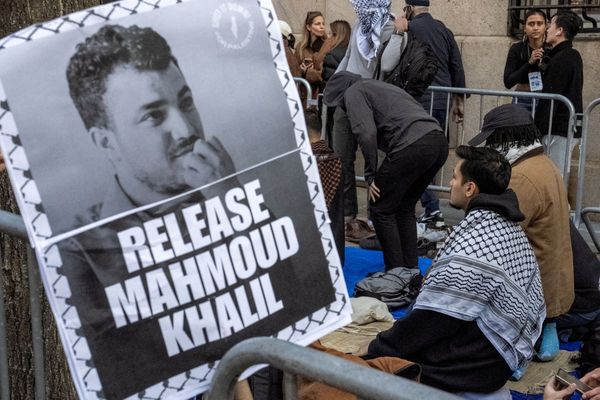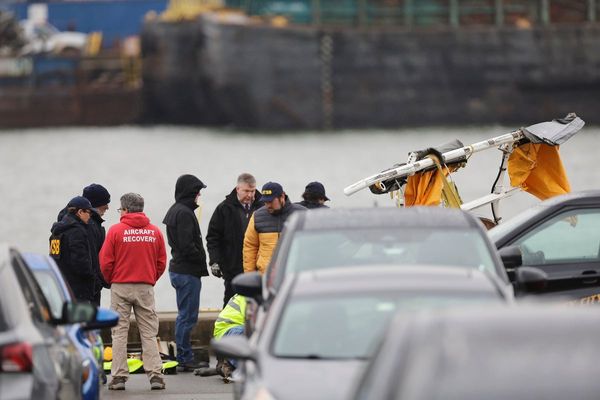Eastern Australia is awash with water — for many, far too much — but on the other side of the Pacific, it is a very different story.
Parts of California are facing unprecedented calls to preserve water.
After three years of failed rains, the Metropolitan Water District of Southern California has declared a storage emergency, requiring "drastic water-use reductions" for six million residents.
This looming disaster comes only a few years after California's previous crippling drought broke in 2017.
It is the latest saga in the Golden State's long and murky history when it comes to water, including miraculous feats of engineering, ingenuity, deception, sabotage and death.
While we sit with full dams, the following is a reminder of the lengths people will go to when the water runs dry.
The rise of William Mulholland
After years working on ships and docks, 1877 found the Belfast-born William Mulholland in the sleepy town of Los Angeles.
The outpost at the end of the rail line was home to 10,000 souls and its main claim to fame being the good weather.
The sun certainly seemed to agree with the 22-year-old Mulholland, who quickly got a job as a ditch digger for the City Water Company.
By hitting the books at night, Mulholland quickly impressed his superiors and rose through the ranks as a self-taught engineer.
Los Angeles was home to 100,000 by the turn of the century, and a slightly greyer Mulholland had risen to become the head of the Water Company.
But as the city grew, it was apparent the Los Angeles River would not be able to meet the demand for water.
Solutions were not close at hand; southern California is basically a desert.
But big problems are not for the short-sighted, and Mulholland's old boss, Fred Eaton, had excellent vision.
Eaton proposed tapping into Owens Lake — an inconvenient 233 miles (375km) from LA but consistently supplied with water from snow melt off the Sierra Nevada Range and conveniently around 4,000 feet (1,200m) above sea level.
A camping trip to the valley was enough to convince Mulholland, who drew up plans for the entirely gravity-fed aqueduct and oversaw the project himself.
But it wasn't just geography standing in the project's way.
The residents of Owens Valley were not keen on the idea of southerners stealing their water, a situation further complicated by a federal reclamation project to expand farmland in the valley.
Yet the reclamation bid was conveniently led by Joseph Lippincott, an Eaton acquaintance, and through appeals to president Theodore Roosevelt and various nefarious dealings, they purchased enough water rights in the Owens Valley to supply the project.
So despite frequent explosive acts of sabotage by Owens Valley residents, progress marched on.
Under Mulholland's command, the aqueduct was completed on time and under budget. It truly was a different time.
In 1913, 40,000 people gathered to watch the first of the water crash down, ready to supply the thirsty Los Angeles.
A victorious Mulholland cried:
"There it is – take it!"
The self-taught Irishman had come a long way from digging ditches.
It all comes crashing down
But the celebrations were short-lived.
The people of Owens Valley continued to fear the aqueduct would be the death of their community and way of life.
It didn't take long before Owens Lake was drained, leaving vast tracts of dust — in the years since, the dry lake bed has been the single largest source of PM-10 dust in the US.
The LA Department of Water and Power has since spent $US2.1 billion in efforts to control the dust, ironically including re-flooding parts of the lake.
But the biggest blow to the project came on March 12, 1928.
Upon the aqueduct's completion it became apparent the city would soon need more water, so Mulholland picked the spot for a dam to be built in the San Francisquito Canyon.
Two years after completion, and as the dam filled for the first time, dam keeper Tony Harnischfeger called in Mulholland to check on some worrying cracks.
Mulholland and the dam's designer inspected the site in person that morning but brushed off the cracks as normal and returned to the city.
Minutes before midnight that night the Saint Francis Dam collapsed, sending its entire contents crashing down upon those unfortunate enough to be in their path.
The dam keeper was among the dead, thought to be washed all the way out to sea.
The night of horror generated stories of heroism, of police motorcyclists outrunning the wave to warn communities downstream, and another of phone operators desperately trying to call ahead to sound the alarm.
But by 5am when the wave reached the sea, hundreds had been swept from their beds. The official death count is around 450 people but is likely much higher.
Many bodies were never found and many migrant and transient people in the region would not have been counted among the missing.
Later inquiries did not blame Mulholland but he took responsibility for the disaster.
In the aftermath, he said:
"Don't blame anybody else, you just fasten it on me.
"If there was an error of human judgement, I was the human."
Regardless of blame, the disaster forever scarred Mulholland's reputation and it ended his career.
Just the beginning
Despite its monumental scale, the Los Angeles Aqueduct is now a relatively small part of the city's water supply.
California's water system is like one of our very own water-schemer John Bradfield's wildest dreams.
The US south-west is crisscrossed with aqueducts connecting distant sources so far-fetched, it is hard to believe it could possibly be contrived today.
Before his retirement, Mulholland was involved with planning an aqueduct to connect LA to the Colorado River.
The scheme eventually resulted in the Colorado River Aqueduct, 242 miles (390km) long, and this time requiring pumps to get it over the mountains.
The Colorado River Aqueduct was completed in 1941 before work began on the mammoth State Water Project in the late 1950s.
The State Water Project's crowning glory is the 444-mile (714km) California Aqueduct — that's pretty much the distance from Sydney to Melbourne as the crow flies.
Yet with all this infrastructure, the state is still struggling to supply its residents with enough water.
Water levels in the Colorado River reservoirs are now so low that discarded remains from decades-old murders have been exposed.
Lake Mead, the biggest man-made reservoir in the US, held back by the Hoover Dam, is now the lowest it has been since it first filled in 1937.
But it is the dwindling supply in the State Water Project that has triggered the latest round of water restrictions in Southern California.
In the past three years the scheme has delivered just 60 per cent of the previously forecast lowest three-year deliveries, or under 20 per cent of its average deliveries, prompting the Metropolitan Water District of Southern California to state:
"We simply don't have enough water to meet normal demands this year.
"This drought is serious and one of the most alarming challenges our region has ever faced. "
The future of water
California's water story is an epic saga of humans crafting tools to let them fly in the face of natural constraints. A hubris that has largely come off.
But it also shows there is only so long we can skirt around the edges of the sun.
Australia may be going through a wet phase, but the dry times will come again.
With climate change gnawing away at any certainty we have in water supply, it will take ingenuity, reviewing how we use our water and a harsh look at where we choose to live, to make sure we do not run out of water.







